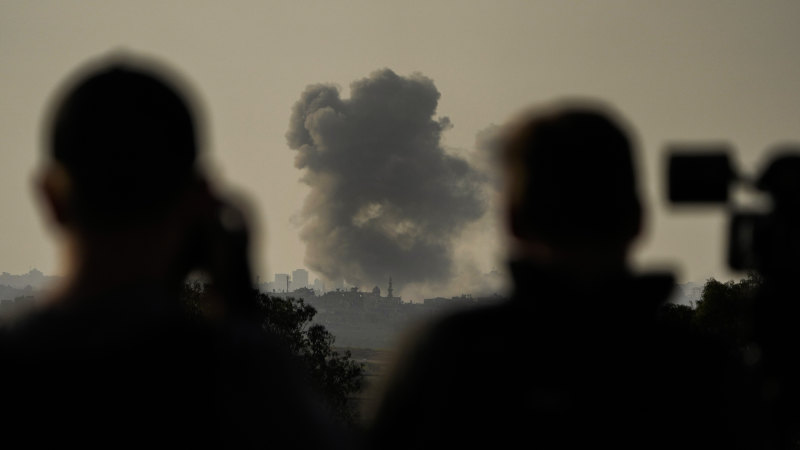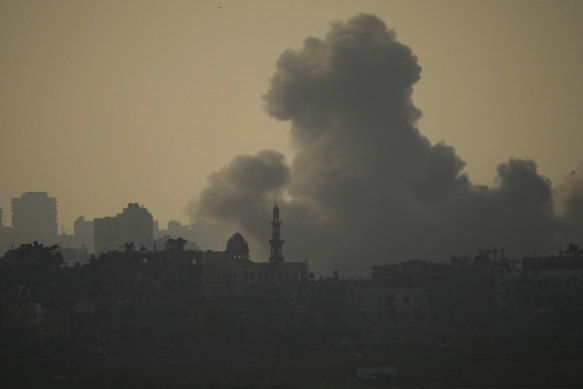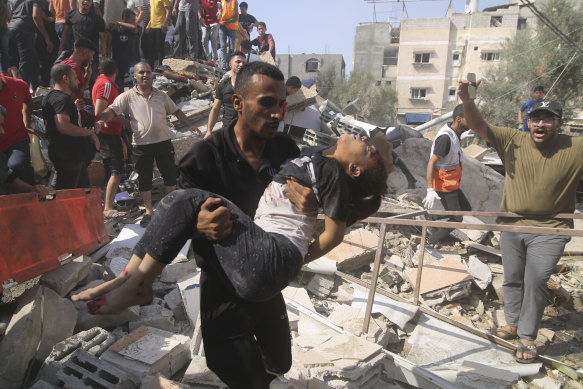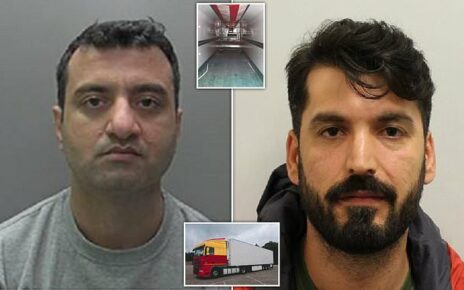Save articles for later
Add articles to your saved list and come back to them any time.
Key points
- Gaza’s health ministry said 436 people had been killed in bombardments over the past 24 hours.
- Israeli’s military said it had struck more than 320 targets in Gaza over that time.
- Hamas said it had released two hostages. The group also fired more rockets into Israel.
- The Israeli army and Palestinians clashed in the occupied West Bank.
- At least 5087 Palestinians have been killed in two weeks of strikes, including 2055 children, the health ministry said.
Gaza/Jerusalem: Israel pounded hundreds of targets in Gaza from the air on Monday while its soldiers fought Hamas militants during raids into the besieged Palestinian enclave where deaths are soaring and civilians are trapped in harrowing conditions.
Hamas also said they released two hostages.
Gaza’s health ministry said 436 people had been killed in bombardments over the past 24 hours, most in the south of the narrow, densely populated territory, next to which Israeli troops and tanks have massed for a possible ground invasion.
Smoke rises following an Israeli airstrike in the Gaza Strip, as seen from southern Israel.Credit: AP
The Israeli military said it had struck more than 320 targets in Gaza over 24 hours, including a tunnel housing Hamas fighters, dozens of command and lookout posts, and mortar and anti-tank missile launcher positions.
The armed wing of the Palestinian Hamas militant group said on Monday it had released two female civilian captives in response to Egyptian-Qatari mediation efforts.
Abu Ubaida, spokesman for armed wing, said on Telegram it had secured the release of the detainees “despite the enemy’s refusal to accept them since last Friday and their neglect of the issue of our prisoners”.
“We decided to release them for humanitarian and poor health grounds … Despite that, the enemy refused to receive them last Friday,” the statement added.
The armed wing released two Americans on Friday, nearly two weeks after Hamas gunmen abducted them and dozens of others near Gaza.
A Qatar foreign ministry spokesperson on Friday said that the release of US hostages from Gaza came “after many days on continuous communication” with all parties.
With the territory’s 2.3 million people running short of basics, European leaders looked set to follow the United Nations and Arab nations in calling for a “humanitarian pause” in hostilities so aid could reach them.
The conflict is escalating beyond Gaza.
Israeli aircraft also hit positions in south Lebanon held by Hezbollah, which, like Hamas, is a group allied to Israel’s long-time foe Iran.
The Israeli army and Palestinians also clashed in the occupied West Bank. And Hamas fired more rockets into Israel.
The UN said desperate Gazans lacked food, water, medicines and places to shelter from the unrelenting pounding that has flattened swathes of the Hamas-ruled enclave.
Some aid was trickling over one border crossing into Gaza, but only a small fraction of the amount needed.
At least 5087 Palestinians have been killed in two weeks of strikes, including 2055 children, the health ministry said.
A man carries a Palestinian girl pulled out of the de house destroyed in the Israeli bombardment of the Gaza Strip in Rafah.Credit: AP
The Israeli bombardment was triggered by an October 7 cross-border assault on Israeli communities by Hamas militants who killed 1400 people and took more than 200 hostage – the bloodiest episode in a single day since the state of Israel was founded 75 years ago.
Israel said its armed forces’ incursions overnight were partly intended to gather intelligence, with the wherabouts of the hostages unknown, and had helped improve its military readiness.
“These raids are raids that kill squads of terrorists who are preparing for our next stage in the war. These are raids that go deep,” military spokesperson Daniel Hagari said.
Hamas’s armed wing, the Izz el-Deen al-Qassam Brigades, said its fighters engaged with an Israeli force that infiltrated southern Gaza, destroying two bulldozers and a tank and forcing the raiders to withdraw.
Israel made no comment on the incident.
The Al-Qassam Brigades also said they were firing missiles at the southern Israeli towns of Ashkelon and Mavki’im. Warning sirens blared out on the Israeli side.
The Israeli military, the Middle East’s most powerful, faces a group that has built up a large arsenal with Iran’s help, fighting in a crowded urban setting and using a vast tunnel network.
The UN humanitarian office (OCHA) said about 1.4 million of Gaza’s population – more than half – were now internally displaced, with many seeking refuge in overcrowded U.N. emergency shelters.
Israel has ordered Gaza residents to evacuate the north. But many who had fled appeared to be returning north due to increased bombardments in the south and lack of shelter.
“They told us to evacuate your place and go to Khan Younis because it is safe… They betrayed us and bombed us,” said 18-year-old Dima Al-Lamdani who lost her parents, seven siblings and four members of her uncle’s family in an air strike after the family moved south.
Early on Monday, Israeli warplanes also struck two Hezbollah cells in Lebanon that were planning to launch missiles and rockets toward Israel, the Israeli military said. Israel also hit a Hezbollah compound and an observation post.
The International Organisation for Migration, a UN agency, said 19,646 people had been displaced inside Lebanon since it began tracking movements on October 8.
In the Israeli-occupied West Bank, two Palestinians were killed at the Jalazone refugee camp near Ramallah, the Palestinian Authority health ministry said.
Residents told Reuters that Israeli forces raided the camp and made many arrests as they clashed with gunmen and some youths who threw stones. The Israeli military said 15 suspects were apprehended, ten of them Hamas operatives.
“Suspects hurled explosive devices and stone blocks from roofs at Israeli security forces, who responded with live fire. Hits were identified,” it said in a statement.
A third convoy of aid entered the Rafah crossing from Egypt on Monday, adding to 34 trucks in the previous two days.
The UN said aid arriving so far was just 4 per cent of the daily average before the hostilities.
In Brussels, European Union leaders meeting later this week will call for a ceasefire to allow aid to flow safely, according to draft conclusions seen by Reuters. They said they backed a similar call from UN Secretary-General Antonio Guterres, who visited Rafah last week. Arab nations also want a truce.
EU officials said the text could still change before the summit. Some countries have expressed reservations about calling for a ceasefire as it could be seen as limiting Israel’s right to self-defence.
Reuters
Get a note directly from our foreign correspondents on what’s making headlines around the world. Sign up for the weekly What in the World newsletter here.
Most Viewed in World
From our partners
Source: Read Full Article



